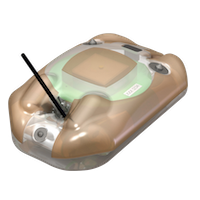
SPLASH10-BF-297
SPLASH10-BF tags remotely track horizontal movements of free-range marine animals that surface quickly and/or infrequently like dolphins, sharks, or turtle—Fastloc® provides GPS-quality locations from tens of milliseconds of surface time.
The SPLASH10-BF tag is an economical alternative to our flagship SPLASH10-F tag. You get all the benefits of Fastloc locations along with a full data archive.
The SPLASH10-BF comes in a variety of attachments—whatever works best for your study animal.
Overview
Fastloc technology is what sets this tag apart. Fastloc uses GPS to provide highly accurate locations in under a second. Fastloc allows for fine-scale locations on animals that surface too quickly for a traditional GPS or Argos fix—Fastloc acquires positions every few minutes compared to a maximum of a few dozen a day with Argos-only tags.
Key Benefits of Fastloc
- Highly accurate—to 20 m with optimal satellite coverage.
- Fast acquisition—even after prolonged sleep, a location can be acquired in a fraction of a second. Very little surface exposure is needed.
- All acquired GPS snapshots are stored for validation post-download.
- Flexible scheduling—fixes can be scheduled at regular intervals or duty cycled depending on day or season.
- Many locations possible—hundreds achievable per day for a higher resolution track.
Key Features of SPLASH10-BF Tags
- Highly Customizable Data Collection and Transmitting Schedule—users can customize and prioritize data transmissions. Deployments can be tailored to achieve unique experimental objectives. Flexible transmissions provide the ability to extend the life of the tag by focusing on specific seasons or times of the year.
- Full Data Archive Available on Recovery—SPLASH10-BF tags contain one GB of onboard memory for archiving data. This means when you recover your tag, your full data set is available, even if the battery is dead—data are maintained in the archive for up to 25 years.
- Specialized Shapes—SPLASH10-BF tags come in over 60 shapes and configurations. They contain an array of sensors that gather a myriad of data products.
- The Portal Advantage—SPLASH10-BF tags are supported by the Wildlife Computers Data Portal, a collection of data management tools and services. Developed specifically for the display and investigation of data from Wildlife Computers tags, the data portal streamlines the processes of acquiring, preserving, and sharing data services. The portal helps collect, prepare, and analyze the data returned from the tag— via Argos or the archive. Data are easily sorted, filtered, searched, uploaded, and shared. You can see a Google Earth display of your deployment track, color-coded to show the relative age of each location. You can also set up a live KMZ to get data into your own monitoring system.
Data Products
Archived Data:
- Temperature
- Wet/Dry
Transmitted Data:
- Argos Locations
- Fastloc
- Haulout Duration & Location (HOB Tool)
- Temperature Time Series
- Time-At-Temperature Histogram (TAT)
- Percent-Dry Timeline
- 20-Minute Dry Timeline
Additional Data Products Available:
- Acceleration 3-Axis Archive
Specifications
Below are the physical specifications of different SPLASH10-BF models. A full description of the features is available on the downloadable SPLASH10-BF Product Features (PDF).
| Sensors | Depth, Temperature, Wet/Dry, Fastloc (light and accelerometer options)*** |
| Depth Sensor Range | 0-2000 m*** |
| Depth Sensor Resolution | 0.5 m*** |
| Depth Sensor Accuracy | ±1% of reading |
| Temperature Sensor Range | -40 °C to 60 °C |
| Temperature Sensor Resolution | 0.05 °C |
| Temperature Sensor Accuracy | ±0.1°C |
| Light Sensor (When Installed) | 5 x 10-12 W cm-2 to 5 x 10-2 W cm-2 |
| Operating Temperature Rating (°C) | -20 °C to 50 °C |
| Optimal Storage Temperature Range (°C) | 0 °C to 5 °C |
| Conductivity Operational Limits | 0.1 to 5 S m-1 |
| Memory | 1 GB |
| Length (mm), Diameter (mm), Weight (g), Pressure Rating, Maximum Deployment Length | *** |
*** indicates the specification is dependent upon the configuration model
